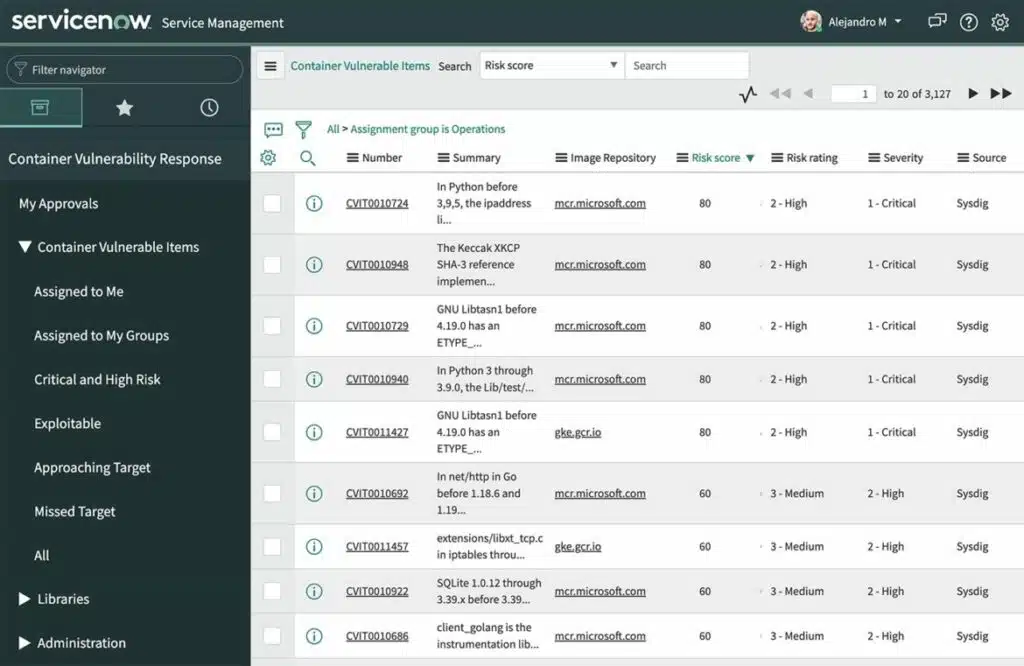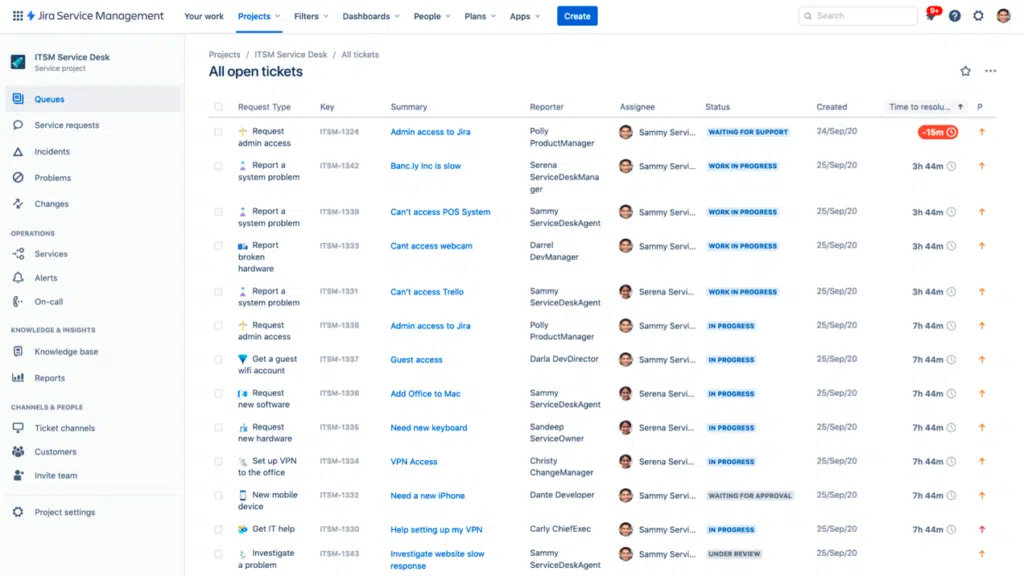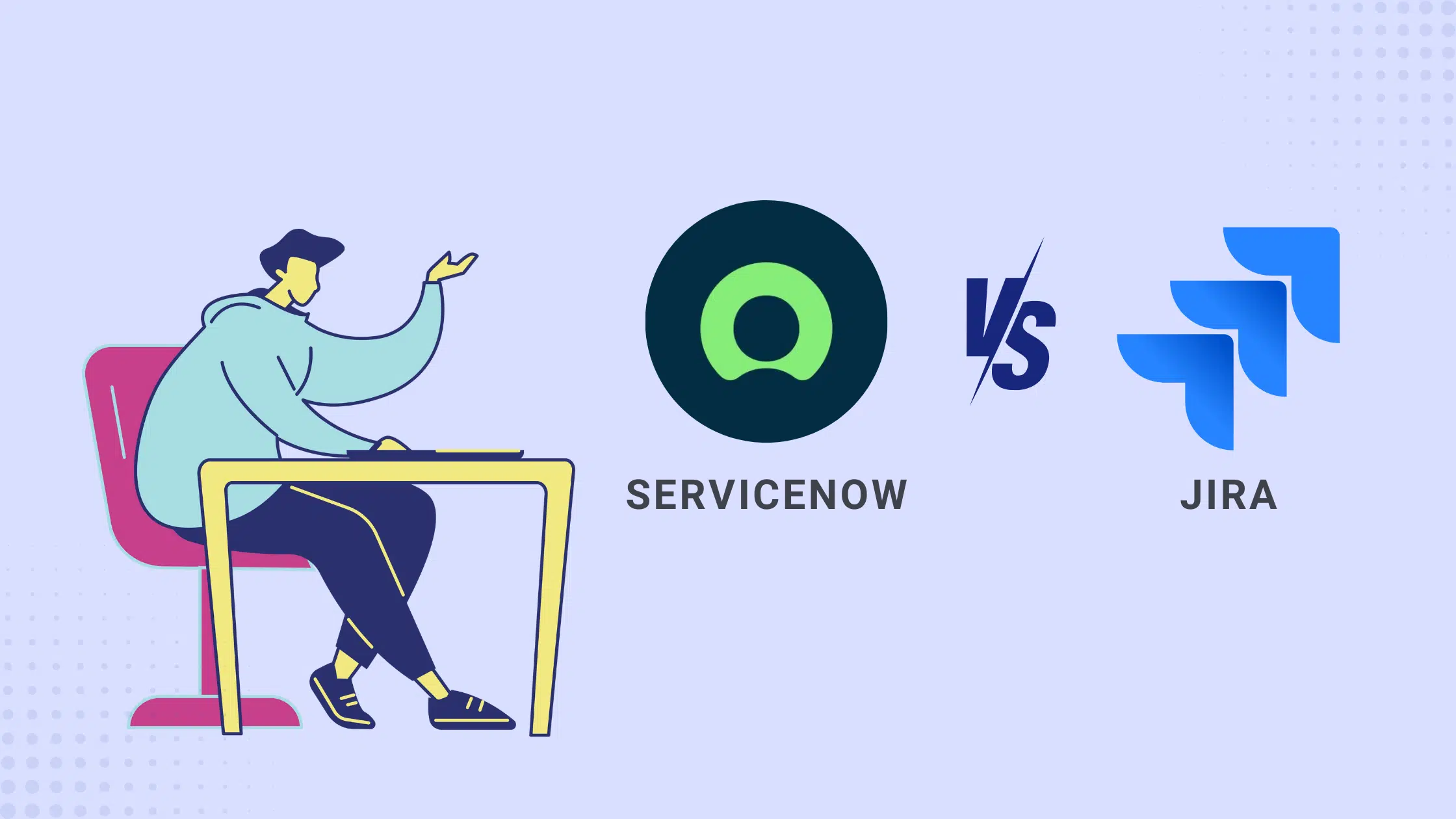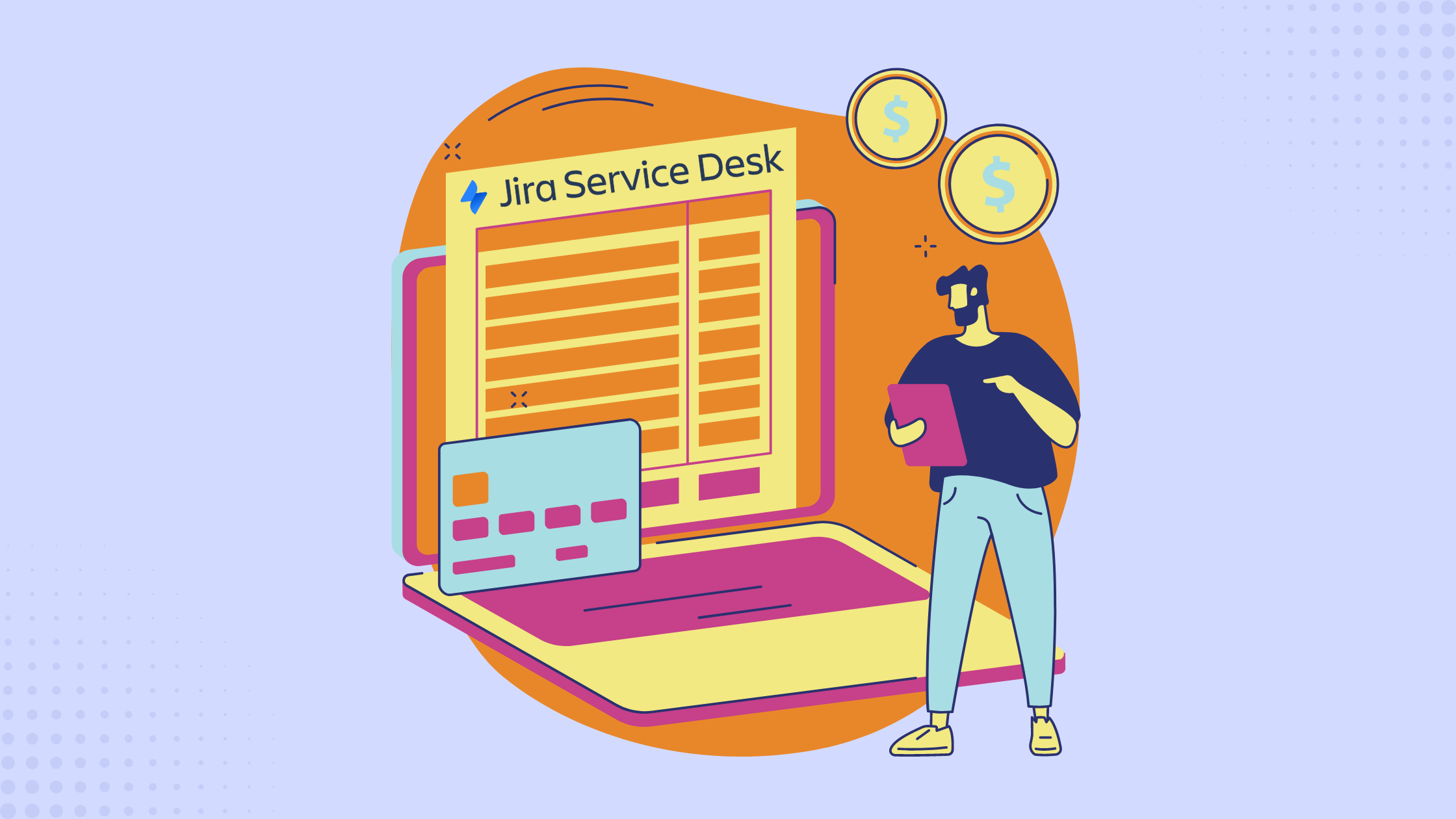When it comes to managing IT services, two big names often come up: ServiceNow and Jira Service Management. Both are heavyweights in the world of IT service management (ITSM), each with its flair. ServiceNow is the go-to for large enterprises that need a comprehensive, all-encompassing solution, offering deep customization and scalability.
On the other hand, Jira Service Management has carved out a niche for teams that value flexibility, speed, and seamless integration with development workflows. So, if you’re caught in the middle of choosing between these two platforms, you’re not alone. Let’s break down what each offers and see which one fits your needs best.
ServiceNow overview
ServiceNow is a cloud-based platform designed to automate workflows and manage IT services, HR, customer service, and more. It’s widely recognized for its IT service management (ITSM) capabilities but also offers features for security operations, software asset management, and HR service delivery. The platform is particularly suited for large enterprises with complex needs and provides an integrated solution for managing multiple business functions.

Key features of ServiceNow
IT service management (ITSM): Automates IT services and adheres to ITIL best practices for incident, change, and request management.
HR service delivery: Streamlines HR processes such as onboarding, employee requests, and case management.
Customer service management (CSM): Manages customer inquiries, complaints, and service requests.
Security operations: Automates security workflows, including incident response and threat management.
Asset & software management: Provides visibility into IT assets and software lifecycle management.
Automated workflows: Enables low-code customization to automate processes across departments.
Analytics & reporting: Offers real-time insights, customizable reports, and performance tracking.
Self-service portal: Lets users submit requests and access knowledge base articles.
Collaboration tools: Facilitates communication and case management within teams.
Integrations: Connects with various third-party applications for seamless service management.
Pricing
ServiceNow uses a subscription-based pricing model, with costs varying depending on the number of users and modules chosen. It tends to be more expensive, making it ideal for large enterprises.
Read more – ServiceNow pricing 2025: The complete breakdown
User experience
The platform has an intuitive interface and can be accessed both on desktop and mobile. It’s designed for users who need a comprehensive solution to manage complex workflows.
Best for
Servicenow is best for large businesses that need a scalable solution to automate IT, HR, customer service, and security operations. Its wide range of features makes it suitable for organizations with complex service management needs.
Key benefits
All-in-one service management platform
Extensive automation and integration capabilities
Real-time insights for data-driven decisions
Scalable for large enterprises
Challenges
High cost and complexity
Steep learning curve for smaller teams
May be too advanced for smaller businesses or simpler needs
Read more – ServiceNow Reviews in 2025
Jira Service Desk overview
Jira Service Desk is a cloud-based service management platform designed to help businesses manage and resolve customer service requests, IT support issues, and internal team requests. It’s built on the Jira platform, which is popular for project management and agile workflows, making it particularly suitable for development teams, IT teams, and service desks. It combines ticket management, automation, and collaboration features to improve efficiency and response times.

Key features of Jira
Incident management: Tracks and resolves issues quickly, ensuring customers and employees get timely support.
Self-service portal: Allows users to submit requests, check status, and access knowledge base articles without direct agent involvement.
SLAs (service level agreements): Helps define and enforce response and resolution times, ensuring consistent service delivery.
Automation rules: Automates repetitive tasks, such as ticket routing and notifications, improving team efficiency.
Knowledge base integration: Allows users to find solutions to common problems before submitting tickets, reducing the workload for support teams.
Reporting and analytics: Offers powerful reporting tools to track performance, customer satisfaction, and service desk metrics.
Customizable workflows: Enables businesses to tailor workflows to their specific needs, especially for IT and support teams.
Collaboration tools: Facilitates team collaboration with features like @mentions, internal comments, and notifications to keep everyone in the loop.
ITIL compatibility: Supports ITIL (IT Infrastructure Library) best practices for IT service management, including incident, problem, and change management.
Integration with Jira Software: Seamlessly integrates with Jira Software, enabling better communication between development and support teams.
Pricing
Jira Service Desk offers a subscription-based pricing model, with pricing based on the number of agents and features. It has tiered pricing, which makes it affordable for small businesses but also scalable for larger organizations. There’s also a free plan for small teams with limited features.
Read more – Jira Service Desk pricing 2025
User experience
Jira Service Desk has an intuitive and clean user interface, making it easy for teams to get started with ticket management and service requests. It’s accessible on both desktop and mobile, ensuring teams can stay on top of support tickets from anywhere. The platform is flexible and customizable, but some users may find the learning curve a bit steep when configuring more advanced features.
Best for
Jira Service Desk is best for IT teams, development teams, and service desks that need an easy-to-use solution for managing support tickets, customer service requests, and internal help desk functions. It’s ideal for organizations already using Jira for project management and looking for an integrated service management tool.
Key benefits
Simple and affordable for small to medium-sized businesses
Easy integration with Jira Software and other Atlassian products
Customizable workflows and automation features
Strong reporting and SLA tracking tools
Intuitive interface for both agents and customers
Challenges
Limited features in the lower-tier pricing plans
It can be complex to set up for larger teams or more advanced use cases
Some users may find the interface a bit cluttered with advanced configurations
Jira Service Desk vs ServiceNow: What are the similarities?
Let’s go deeper into the similarities between Jira Service Management and ServiceNow, focusing on specific features, workflows, and how they align with modern IT service management best practices.
1. Incident management
Both Jira Service Management and ServiceNow are equipped to handle incident management, which is crucial for IT service teams when responding to service disruptions or user-reported issues.
Jira Service Management offers a simple, agile approach to incident management. It allows IT teams to quickly log incidents, categorize them, and assign them to appropriate teams. The platform uses customizable SLA (Service Level Agreements) to ensure that incidents are resolved within the agreed-upon timeframes.
ServiceNow, on the other hand, offers a more comprehensive ITIL-based approach. It is designed to align with industry standards like ITIL (Information Technology Infrastructure Library) and is highly configurable for more complex workflows. ServiceNow’s Incident management integrates tightly with other ITSM processes like Problem management and Change management, creating a more holistic approach to managing incidents.
Both platforms allow teams to prioritize incidents based on severity and impact, automate incident categorization, and provide users with real-time updates.
2. Request management
Request Management is a common feature in both systems, enabling users to submit service requests like password resets, access to software, or hardware requests.
Jira Service Management is known for its user-friendly interface and simplicity, making it easy for end-users to submit requests through a self-service portal. It also supports custom request types and offers features like approval workflows and automated ticket routing to appropriate teams.
ServiceNow offers a more enterprise-grade approach with a self-service portal that supports a wide variety of service catalog items. ServiceNow’s Request Management is deeply integrated with its broader platform, including procurement and IT asset management, which makes it highly scalable for large enterprises. It offers advanced features like automatic task creation for complex requests and workflows that require multiple steps across different departments.
Both platforms ensure a smooth experience for users and help IT teams streamline the service request process, ensuring faster response times.
3. Change management
Change Management is a crucial process for controlling changes to IT systems and services, minimizing risk, and maintaining service availability.
Jira Service Management integrates change management with other workflows in an agile way. It provides a flexible change approval process and allows IT teams to document and track changes through custom workflows. Jira’s change management capabilities are particularly well-suited for DevOps environments, where fast-paced, frequent changes are the norm.
ServiceNow offers a robust ITIL-compliant Change Management process with built-in workflows for the assessment, approval, and implementation of changes. It integrates change management with problem management, incident management, and configuration management, providing a more comprehensive view of changes across the organization. ServiceNow also offers a change calendar, allowing IT teams to visualize and schedule changes to avoid conflicts and reduce disruptions.
While Jira Service Management focuses on speed and agility in change management, ServiceNow provides a more structured and enterprise-grade approach, with better support for large-scale change processes.
4. Knowledge base
A knowledge base helps users find solutions to common problems and reduces the volume of support tickets.
Jira Service Management allows IT teams to create and manage a knowledge base directly integrated with the service desk. The Confluence integration enables seamless access to knowledge articles, ensuring that users can easily search and resolve issues without needing to submit a request. Jira’s knowledge base is straightforward, allowing for easy creation and updates of articles.
ServiceNow offers a comprehensive knowledge management system that integrates with all ITSM processes. It allows teams to create rich, detailed knowledge articles that can be linked to incidents, problems, and changes. Additionally, ServiceNow’s knowledge base supports advanced analytics to track article performance and gather insights on user engagement.
Both systems leverage knowledge bases to improve efficiency and reduce support workloads, though ServiceNow’s offering is more expansive with deeper integration into the organization’s entire IT service management ecosystem
5. Automation
Automation is a game-changer in ITSM because it can help reduce manual errors, improve response times, and ensure consistency in processes.
Jira Service Management offers powerful automation rules that are highly customizable. Users can automate tasks like ticket routing, prioritization, notifications, and escalations based on predefined conditions. This automation is particularly beneficial in fast-moving environments, like DevOps or IT teams that need quick turnarounds.
ServiceNow offers advanced automation built around its ITIL processes. The platform supports automation across all ITSM workflows, including incident management, change management, and service requests. ServiceNow’s automation includes features like dynamic task assignment, automated approval workflows, and AI-powered suggestions for quicker decision-making. The platform’s automation capabilities are built for complex, enterprise environments, providing deep integration with other IT systems.
Both platforms focus on automating manual workflows, but ServiceNow is more suitable for large-scale enterprises requiring more sophisticated and complex automations, while Jira Service Management provides a more intuitive and agile approach.
6. Reporting and analytics
Data-driven decision-making is essential for improving service delivery and efficiency.
Jira Service Management offers a flexible reporting suite that enables teams to generate custom reports on a variety of metrics, including SLA compliance, ticket volume, resolution time, and more. With Jira’s native integrations with Confluence and advanced filters, teams can create detailed dashboards that track performance and identify areas for improvement.
ServiceNow provides a robust analytics and reporting suite that includes out-of-the-box ITIL metrics like mean time to resolve (MTTR), SLA performance, and change success rates. It also offers powerful business intelligence (BI) tools to create custom reports and interactive dashboards. ServiceNow’s analytics can be deeply integrated with other enterprise data systems, enabling a broader organizational view.
While both platforms provide powerful reporting, ServiceNow’s analytics tend to be more feature-rich and suited for larger, complex organizations, while Jira Service Management offers more flexibility and ease of use for smaller teams and fast-moving projects.
Jira vs ServiceNow: What are the differences?
1.ServiceNow offers greater customization, Jira is more user-friendly
ServiceNow is an incredibly versatile platform, giving businesses the power to fully customize and adapt the system to their specific needs. Whether you’re dealing with complex IT service management processes or need a tailored HR workflow, ServiceNow allows you to design everything from scratch or modify existing templates. This level of flexibility is powerful but can also require a steeper learning curve and more dedicated resources for setup and ongoing management.
On the flip side, Jira’s focus is on simplicity and ease of use. Its user interface is intuitive, and teams can start using it with minimal training. Jira’s emphasis on ease of use means that while it may lack some of the deep customization features of ServiceNow, it’s often easier for teams to implement, especially in fast-moving or smaller organizations where agility and speed are priorities.
2. ServiceNow is ideal for enterprise solutions, Jira fits agile teams
ServiceNow is built for large enterprises that need to manage a wide array of services and workflows across multiple departments. It’s a powerful solution for organizations with complex needs, such as managing IT service requests, employee onboarding, security operations, and even customer service. ServiceNow’s ability to integrate various service management functions into a single platform is a huge advantage for larger organizations.
Jira, on the other hand, is specifically designed for agile development teams. Its features are centered around managing software development projects, such as tracking tasks, user stories, and sprints. Jira’s flexibility makes it ideal for agile teams that follow methodologies like Scrum or Kanban. It’s a more nimble solution, tailored to fast-paced environments where changes can happen quickly, and teams need a tool that helps them stay organized and aligned on projects.
3. ServiceNow provides a broader suite of features, Jira specializes in project management
When it comes to functionality, ServiceNow offers a much broader suite of tools. Its capabilities extend far beyond project management into areas such as IT service management (ITSM), HR services, asset management, and customer service management. This makes ServiceNow an enterprise-grade solution that can handle a variety of business needs in a single platform. If you’re looking to manage everything from service requests to employee workflows, ServiceNow is an all-in-one solution.
Jira, however, focuses exclusively on project management, particularly for agile teams. While it’s an excellent tool for tracking work items, managing backlogs, and organizing sprints, it doesn’t extend beyond the realm of project management. So, while it lacks the broader features of ServiceNow, Jira excels in its niche, offering powerful tools for teams that need to stay on top of complex project management needs—especially in software development.
4. ServiceNow is more expensive, Jira is more cost-effective
One of the most significant differences between ServiceNow and Jira is the cost. ServiceNow’s extensive features and customization options come with a hefty price tag, often making it more suitable for large enterprises with deep pockets. The price can also scale depending on the number of users and the level of customization you require. However, for large organizations that need a comprehensive service management platform, the investment is often justified by the robust capabilities and integrations that ServiceNow offers.
Jira, by contrast, is far more budget-friendly, especially for small to medium-sized businesses. Its pricing tiers are more accessible, and it offers a solid set of features for teams that don’t need the full breadth of ServiceNow’s functionality. For companies that are looking for a simple yet powerful tool for managing projects and tracking tasks without breaking the bank, Jira offers great value.
5. ServiceNow offers stronger ITIL compliance, Jira focuses on agile methodology
If you need a tool that adheres to ITIL (Information Technology Infrastructure Library) best practices, ServiceNow is the clear winner. ITIL is a framework for IT service management that provides structured processes for incident management, change management, and service delivery. ServiceNow is built around ITIL guidelines, and its features are designed to help businesses manage their IT services in a highly organized and compliant way. This makes ServiceNow the go-to platform for large enterprises that require strict governance and a standardized approach to service management.
Jira, on the other hand, focuses primarily on agile methodologies. It’s tailored for teams working in an iterative, flexible, and collaborative environment. Jira excels in managing backlogs, creating user stories, tracking sprints, and facilitating agile workflows, making it an ideal tool for software development teams that use Scrum or Kanban. If your team is more focused on agility and flexibility than on formal IT service management, Jira is the better choice.
Why Desk365 is better than ServiceNow and Jira Service Desk
Desk365 can be a better choice over ServiceNow and Jira Service Desk for a number of reasons, especially when it comes to ease of use, cost-effectiveness, and suitability for small to medium-sized businesses. Here’s why Desk365 might be the better option:
1. User-friendliness
Desk365 offers a simple, intuitive interface that is easy to navigate. It’s designed with customer support teams in mind, so users can manage tickets, workflows, and customer requests with minimal training.
ServiceNow and Jira Service Desk (now Jira Service Management) both have more complex interfaces. ServiceNow is robust but often requires significant resources for configuration. Jira Service Desk can be overwhelming for teams not familiar with the larger Jira ecosystem.
2. Cost-effectiveness
Desk365 is more affordable, especially for small to medium-sized businesses. Its transparent pricing model allows companies to budget easily without worrying about hidden fees.
ServiceNow is typically much more expensive and is geared towards large enterprises. The cost of implementation, licensing, and customization can be very high, making it less ideal for smaller organizations.
Jira Service Desk is affordable at first, but as your needs grow (with additional features, integrations, or add-ons), the costs can increase.
3. Quick setup and implementation
Desk365 is quick to set up and deploy. With pre-configured workflows and templates, teams can get started right away without spending much time on customization.
ServiceNow requires a longer implementation period due to its complex configuration and customization options. It can take weeks or even months for full deployment.
Jira Service Desk also requires configuration, especially if your team isn’t already using other Jira tools. While quicker than ServiceNow, it still requires more effort than Desk365.
4. Automation and AI
Desk365 includes built-in AI-driven automation to route tickets, provide self-service options, and automate repetitive tasks. This helps improve efficiency and reduce manual workload.
ServiceNow also offers automation, but setting it up can be complex and often requires technical expertise.
Jira Service Desk offers automation for ticketing, SLA management, and incident response, but it’s more geared towards IT workflows than customer support.
5. Scalability
Desk365 is scalable for growing businesses. It offers flexible plans and features that can expand as your team and business needs grow.
ServiceNow is highly scalable, but its complexity and cost make it more suitable for large enterprises rather than smaller businesses.
Jira Service Desk scales well for teams that are already using other Atlassian products, but it might require extra customization for complex ITSM needs.
See what a Desk365 user had to say on G2!
Super quick to set up, very cost effective, very flexible, great for automation and assigning tickets to the right queue. Customer support is very quick to respond if you need them. We were able to integrate this very easily and had this up and running within the day, no hesitation in recommending.
It also was super easy to get the bot working in Teams and lots of our users use this method for raising and checking on tickets
I’ve used some of the bigger packages and prefer to use this.
Omni-Channel
- Microsoft Teams Ticketing
- Email Ticketing
- Customer Support Portal
- Web Form/Web Widget
- Unified Inbox
Process Automation
- Automation Rules
- Custom Response Templates
- Canned Responses
- Tasks/To-do Lists
- Time Tracking
- SLA Management & Business Hours
- SLA Reminders & Escalations
- Multiple SLAs
- SLAs in Automations
Ticket Management
- Custom Ticket Views
- Customer Management
- Responsive Mobile Web Apps
- Multiple Emails
- Multiple Groups/Departments
- AI Agent
- Collision Detection
- Closure Rules
- Knowledge Base
Data & Analytics
- Customer Surveys & Reports
- Ticket Trend Reports
- Productivity/SLA Reports
- Export Data
- Import Data
Customization
- Custom Email Servers
- Custom Ticket Fields
- Custom Forms
- Custom Roles
- Custom Reports & Graphs
- Remove Desk365 Branding
Integrations
- Entra ID Single Sign-on
- API Access
- Web-hooks
- Power Automate Connector
- Microsoft 365 Copilot Plugin
Support
- Free Setup and Installation
- Priority Support
Overall, while both ServiceNow and Jira Service Management are powerful and widely adopted ITSM solutions, Desk365 stands out as a refreshing alternative — combining simplicity, affordability, and a robust feature set designed for modern support teams.
Make the smart move today by choosing the right customer support software. Sign up for a free trial and see how Desk365 can streamline your support operations and elevate your customer experience.








